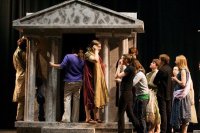Creating Successful Collaborations
For the past five years I have collaborated with a playwright who works with my students as they write original plays. Each year, on the first day that she has been in the room with us, Kate and I stage a conflict about what should come next in the lesson. As students squirm uncomfortably in their seats and turn to each other with unbelieving eyes, Kate and I debate what makes the most sense to do next. The goal of the staged conflict is getting students to think about the crucial role of conflict in drama and playwriting. We use our brief skit as a way to open up a larger conversation about the power of theater and the different elements of a play.
Although we never feel that our acting is very convincing, we have been amazed to see and hear the intensity of student responses to these moments of classroom confusion and leadership uncertainty. Outside collaborations can lead to profound experiences for students, but, as our moments of staged conflict have demonstrated, collaborations can also be precarious -- and students quickly sense (real) moments when things are not proceeding as planned.
The Right Mix
I both actively pursue classroom collaborators and agonize about welcoming others to come work with my students. I want them to have real-world experiences that will take them (both physically and virtually) beyond classroom walls. By collaborating with experts in different fields, my students are able to immerse themselves in experiences and projects in authentic and meaningful ways.
At the same time, dysfunctional collaborations can be incredibly frustrating for teachers and students. No one benefits from classroom visitors who are unpredictable or talk down to young people. Visitors must be willing to listen and not enter with an attitude that their presence means students should act as passive receptacles of information. We all know that young people are quick to sense condescension and will feel insulted by someone who does not respect their knowledge.
Two successful ongoing collaborations that I have established for my classes involve artists who teach their craft and then provide extensive feedback as students create their own projects. These collaborations have taught me about several ingredients that seem crucial to successful teacher/collaborator/student relationships.
Guidelines for Successful Classroom Collaborations
1. Establish an Environment of Shared Leadership and Ownership
It must be clear to students that outside collaborators are also classroom leaders. I give students many reasons to get excited about collaborations (working with a professional in their field, an opportunity to try an entirely new creative project, etc.), and then I make sure that the collaborators are leaders in running the class. At the same time, I am an active participant in the process. I work hard to make sure student voices continue to be heard, and I speak up if something is unclear or there is a connection that seems important to make. If any students are shying away from participation in activities, I approach them on the side and try to find out what they need to make them feel comfortable participating.
2. Plan Together and Create Common Goals
Successful collaborations are built on a shared vision. The planning process is a chance to co-create this vision by investigating and working with the strengths of each participant. Use planning to create specific learning goals for students and also to discuss classroom norms and strategies for sharing leadership and responding to students.
3. Communicate Regularly and Reevaluate
All classroom units and all relationships have their moments of struggle. Respond to these challenges proactively and with openness. Make space for students to communicate any issues that they may have, and regularly check in with classroom visitors about how they think the project is working. Revise or tweak lessons when necessary.
4. Value and Celebrate Student Work
Classroom collaborations should be designed around the idea of students creating. After classroom visitors model or teach, they should then switch to the role of assistant or consultant. This allows students to become the ones who are having the primary, active learning experiences.
5. Fundraise Together!
Collaborations cost money, but there are many arts grants that contain education components. Approach artists and experts, and find out if they are willing to write a grant with you. Pursue funding from your Home & School Association or other local organizations. One of my collaborations began when a dance company was looking for schools to fulfill a requirement of a grant they had received.
Powerful Rewards
I would never have imagined that I would have an annual collaboration with a site-specific dance company and that every year my students would present pieces that they created as part of a larger public art festival (see video). Without inspiration from outsiders, I could have never envisioned different public art projects that allowed my students to transform the city around our school (as described in this Edutopia post and photo album). I will never forget the look on a student's face as she spoke to a full theater about a play she had written that had just been produced at a local university.
Collaborations give our students access to experts and experiences that transform all of us, students and teachers alike. As teachers, it is our job to connect with those who do inspirational work in the world, and to design experiences that will enable our students to access and express new sides of themselves. Why not use the summer to find a new collaborator? It's never too soon to connect with someone in the community who can inspire you and your students to create powerful work in the world during the next school year!
